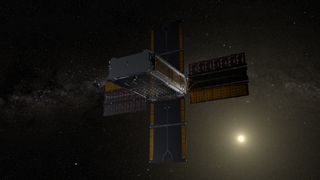NASA's Artemis 1 moon mission will carry the world's 1st deep-space biology experiment
To boldly go where no yeast has gone before.

NASA's next rocket launch will have a few hitchhikers onboard.
When the Artemis 1 mission launches, currently scheduled for Aug. 29, the new Space Launch System (SLS) rocket will take to the moon not only NASA's next-generation Orion capsule, but also 10 tiny cubesats. One of those cubesats is the BioSentinel mission, which will be the first long-duration biology experiment in deep space. (Biology experiments have thus far been limited to the Earth-moon system.) The cubesat, which is carrying yeast cells, will enter an orbit around the sun similar to that of Earth's. From there, scientists will study how space radiation affects yeast cells.
"BioSentinel is the first of its kind," Matthew Napoli, BioSentinel project manager at NASA's Ames Research Center in California, said in a statement. "It will carry living organisms farther into space than ever before. That's really cool!"
Related: NASA's Artemis 1 moon mission explained in photos
Space radiation forms when atoms travel so quickly they lose their electrons, leaving behind just the nucleus, according to NASA. The agency calls such a particle "an atomic-scale cannonball" because of the damage radiation can cause. Earth's magnetic field protects most humans from space radiation, which can otherwise cause cancer and other diseases.
And when astronauts leave low Earth orbit for long-duration missions, they'll be left exposed, hence NASA's interest in studying radiation and its impacts. The BioSentinel mission is part of this research. Because yeast cells have similar biological mechanisms as human cells — perhaps most importantly, both organisms carry genetic information in double strands of DNA — they can serve as a test subject for radiation experiments to demonstrate what might happen to humans in a similar situation.

The yeast cells will begin their journey dry, housed in small cards stored aboard the cubesat. As Artemis 1 blasts toward the moon, BioSentinel will part ways and enter its deep-space orbit around the sun. Once the cubesat is out of range of Earth's magnetic field, mission personnel will strategically activate the yeast over the course of 12 months, and the research will begin.
Get the Space.com Newsletter
Breaking space news, the latest updates on rocket launches, skywatching events and more!
BioSentinel is actually one of a trio of identical experiments: one will happen aboard the International Space Station, and another will happen on Earth. With this data, scientists can compare the effects of radiation on Earth, in low Earth orbit and in deep space, helping to pave the way for crewed missions to Mars and beyond.
Follow Stefanie Waldek on Twitter @StefanieWaldek. Follow us on Twitter @Spacedotcom and on Facebook.
Join our Space Forums to keep talking space on the latest missions, night sky and more! And if you have a news tip, correction or comment, let us know at: community@space.com.

Space.com contributing writer Stefanie Waldek is a self-taught space nerd and aviation geek who is passionate about all things spaceflight and astronomy. With a background in travel and design journalism, as well as a Bachelor of Arts degree from New York University, she specializes in the budding space tourism industry and Earth-based astrotourism. In her free time, you can find her watching rocket launches or looking up at the stars, wondering what is out there. Learn more about her work at www.stefaniewaldek.com.
Most Popular


